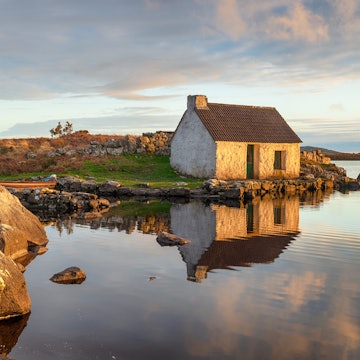

From prehistoric sites to the sandy beaches, plus spotting puffins and dining out on fresh seafood. Huw Penson/Shutterstock
The Pembrokeshire coast is what you imagine the world would look like if a geology teacher with artistic yearnings had their way. This rugged corner of Wales is dominated by knobbly hills of volcanic rock, thin, glacier-scoured inlets, and stratified limestone eroded into arches, blowholes and sea stacks.
All along the shoreline, towering red and grey cliffs are interleaved with perfect sandy beaches. This phenomenally wild landscape is one of the UK’s greatest assets, and in summer, it beckons with spectacular walking, surfing, coasteering and sea kayaking.
Natural assets aside, Pembrokeshire offers a wealth of Celtic and pre-Celtic sites, forbidding castles, fascinating islands and little St Davids – a magical mini-city with a chilled vibe, medieval cathedral and abiding association with Wales' patron saint. Here are the best things to do in Pembrokeshire.
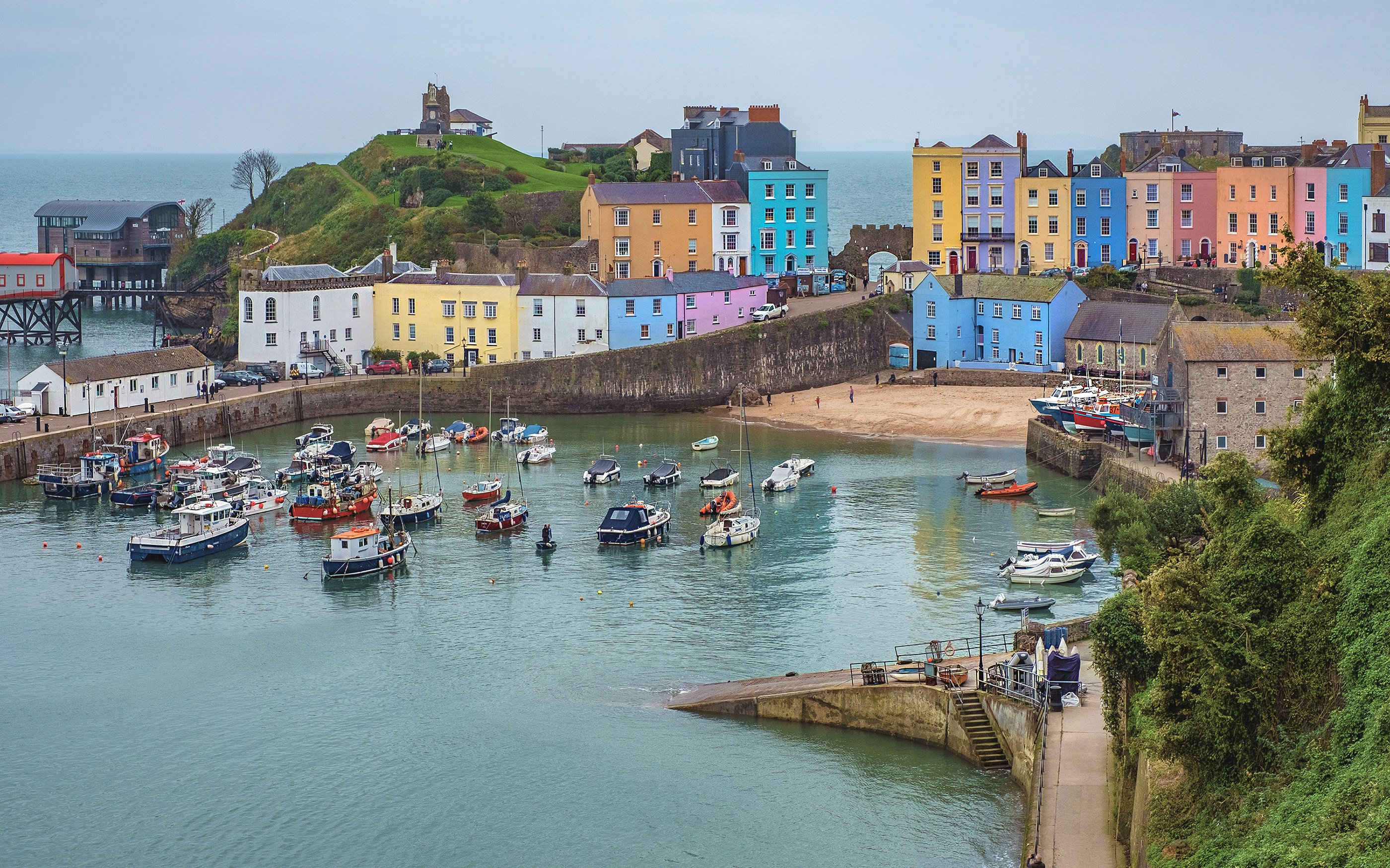
1. Soak up the seaside town vibe in Tenby
Held high on a headland with magnificent sandy beaches on either side, Tenby is the Pembrokeshire of a million postcards, with Georgian houses lavishly painted in pastel tones, gathered around a harbour where fishing boats bob. Tenby's heart is still rimmed by Norman-built walls, funnelling holidaymakers through medieval streets lined with pubs, ice-cream parlours and gift shops. In summer, it has a boisterous, holiday-resort feel, but it tastefully returns to being a sleepy little place in the low season.
Tenby’s headland is bookended by two gorgeous smiles of golden sand – cliff-rimmed Castle Beach, gazing out to St Catherine’s Island and its Napoleonic fort (you can walk there at low tide), and North Beach, with the jagged fang of Goscar Rock. For something quieter, trudge along the coast path to invigoratingly wild Monkstone Beach, where you can splash in rock pools and gather razor clams at low tide.
2. Watch falconry displays at Carew Castle
Looming romantically over the River Carew, and photogenically reflected in the glassy water, this formidable castle often elicits gasps of wonder. The rambling limestone ruins range from functional 12th-century fortifications to an Elizabethan country house, and there are plenty of towers, wall walks and dank basements to explore. A summer line-up of events includes archery, falconry, battle re-enactments and an open-air theater.
The historic tidal mill at the castle is the only intact mill of this kind in Wales. Waters from the incoming tide were trapped in a pond and then released through sluice gates to turn the waterwheels. For 400 years until 1937, the mill ground corn for the castle community, although the present building only dates from the early 19th century.
Detour: Near the castle entrance is the 11th-century Carew Cross; covered in intricate Celtic carvings and standing 4m (13ft) tall, it's one of the grandest of its kind.

3. Spot puffins (and more) on Skomer Island
Rain or shine, Skomer Island is pure magic. Board the first morning boat to bounce across choppy seas to this rocky island, where ancient volcanic cliffs punch above the tide-ripped Atlantic Ocean. Come summer, pink thrift and white sea campion create a mass of scent and flower on the island’s slopes, and thousands of seabirds ride the breeze: kittiwakes and peregrines, terns, fulmars, choughs, red-billed oystercatchers, and puffins. So many puffins!
With 48,000 puffins on Skomer Island, it's easy to get close to these lovably comical birds. Follow the 4-mile (6.5km) circular trail around the island in summer for close-ups of puffins preparing their nests, bringing sand eels in for their newly hatched pufflings, darting across the path, and groaning in their burrows. Skomer is also the nesting ground and summer home of some 350,000 pairs of Manx shearwaters – the world’s largest colony.
4. Eat your way around the foodie enclave of Saundersfoot
When it comes to food, Saundersfoot's star just keeps rising, with chefs riffing creatively on the freshest regional ingredients. On wave-bashed Coppet Hall Beach, Hywel Griffith and Gerwyn Jones walk the culinary high-wire at Lan y Môr. Here, ingredient-led menus big up Welsh flavours in dishes such as katsu curried Angle Bay oysters with pickled ginger, and the Gower salt marsh lamb burger with Snowdonia cheese – all served with a knockout view of the setting sun.
In a harborfront shack nearby, the Stone Crab lets boat-fresh seafood shine in dishes like posh fish and chips (lobster with rustic fries). More casual is Cŵlbox at Wisemans Bridge, where bang-bang prawns, crispy squid and cockle popcorn are served from a converted horsebox (scoff them on the picnic bench).
Smoky, air-cured Celtic lamb, wild garlic preserved in its life cycle, limpet mousse with littoral-zone seaweeds, fermented crab apple sorbet… The 10-course menu at Michelin green-starred Annwn in nearby Narberth is an ode to Pembrokeshire’s wild seas, shores, hedgerows and bucket-wielding foragers. Here, Matt Powell revives ancient Welsh recipes in a multi-course feast. For more insight, join Dan Moar to forage for ingredients beforehand.
5. Roam the secret gardens of Colby Woodland
The National Trust-run Colby Woodland Garden is an enchanting pocket of greenery, hidden in a valley 4 miles (6.5km) northeast of Saundersfoot. A magic wand has been waved on this former working coal field, reborn as conservation-driven woodlands, gardens, and rewilded meadows pulsing with bugs, butterflies and bees. You may spot wood warblers, dippers, Bechstein’s bats, frogs and even the odd otter.
Come in spring and summer to wander among bluebells, rhododendrons, camellias, azaleas, magnolias and hydrangeas. Autumn is perfect for leaf-peeping with fall colours on the woodland trail.
Local tip: Check out the woodland garden, with its 41m-high (135ft) Japanese redwood (the UK’s tallest) and views across Carmarthen Bay, and the walled garden with its water features and sculptures.
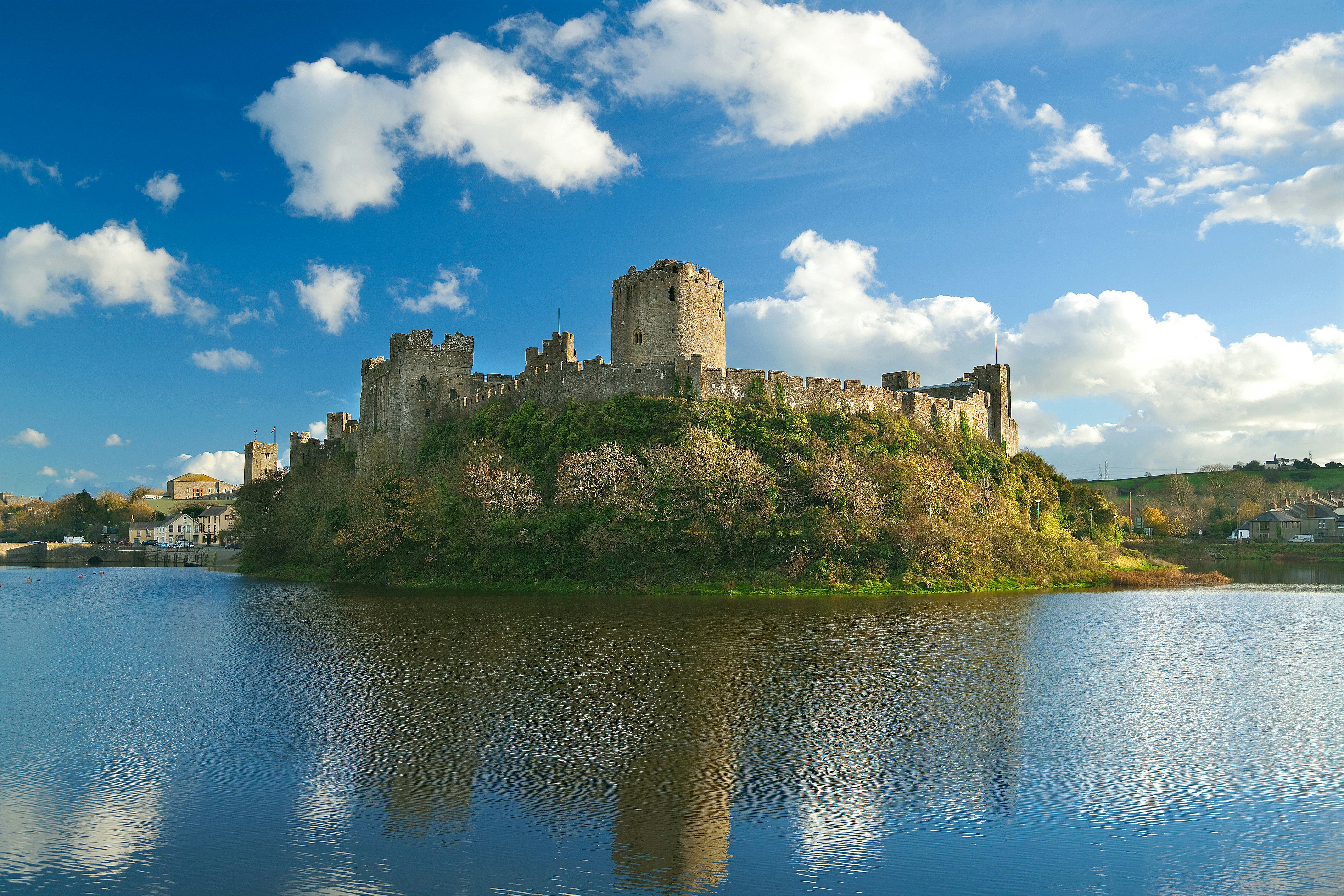
6. Be impressed by Pembroke Castle
This spectacular and forbidding castle was the home of the earls of Pembroke for over 300 years and the birthplace of Henry VII, the first Tudor king. A fort was established here in 1093 by Arnulph de Montgomery, but most of the present buildings date from the 13th century. The oldest part of the complex is the sinister, looming keep, dating to 1204.
One hundred steps lead to the top, from where there are great views over the town. Next to the keep is the Dungeon Tower, where you can peer into a dank, dark prison cell. Nearby, with access through the Northern Hall, are steps to the creepy Wogan Cavern, a large natural cave that was partially walled in by the Normans and probably used as a store and boathouse.
It's a great place for both kids and adults to explore – wall walks and passages run from tower to tower, and vivid exhibitions detail the castle's history. In the summer school holidays, there are a host of activities here for kids, from falconry displays and costumed re-enactments to Knight School and outdoor theater events.
7. Explore the night skies in Pembrokeshire
When night falls in the Pembrokeshire Coast National Park, the stars blaze. These skies are some of Britain’s darkest, and little else beats heading to a beach, listening to the rumble of the sea and peering up at the heavens. Minimal light pollution means it’s often possible to see the silvery spray of the Milky Way, distant planets, shooting stars, and constellations like the Plough and Orion with the naked eye alone.
For real celestial magic, zoom in on the park’s eight Dark Sky Discovery Sites, which include stargazing hotspots like Broad Haven South, Newgale Beach, Skrinkle Haven and Martin’s Haven car parks, and Poppit Sands beach.
Planning tip: Take binoculars, a telescope or an SLR camera to glimpse nebulae and meteor showers (best observed in August, November and December) in all their radiant detail.
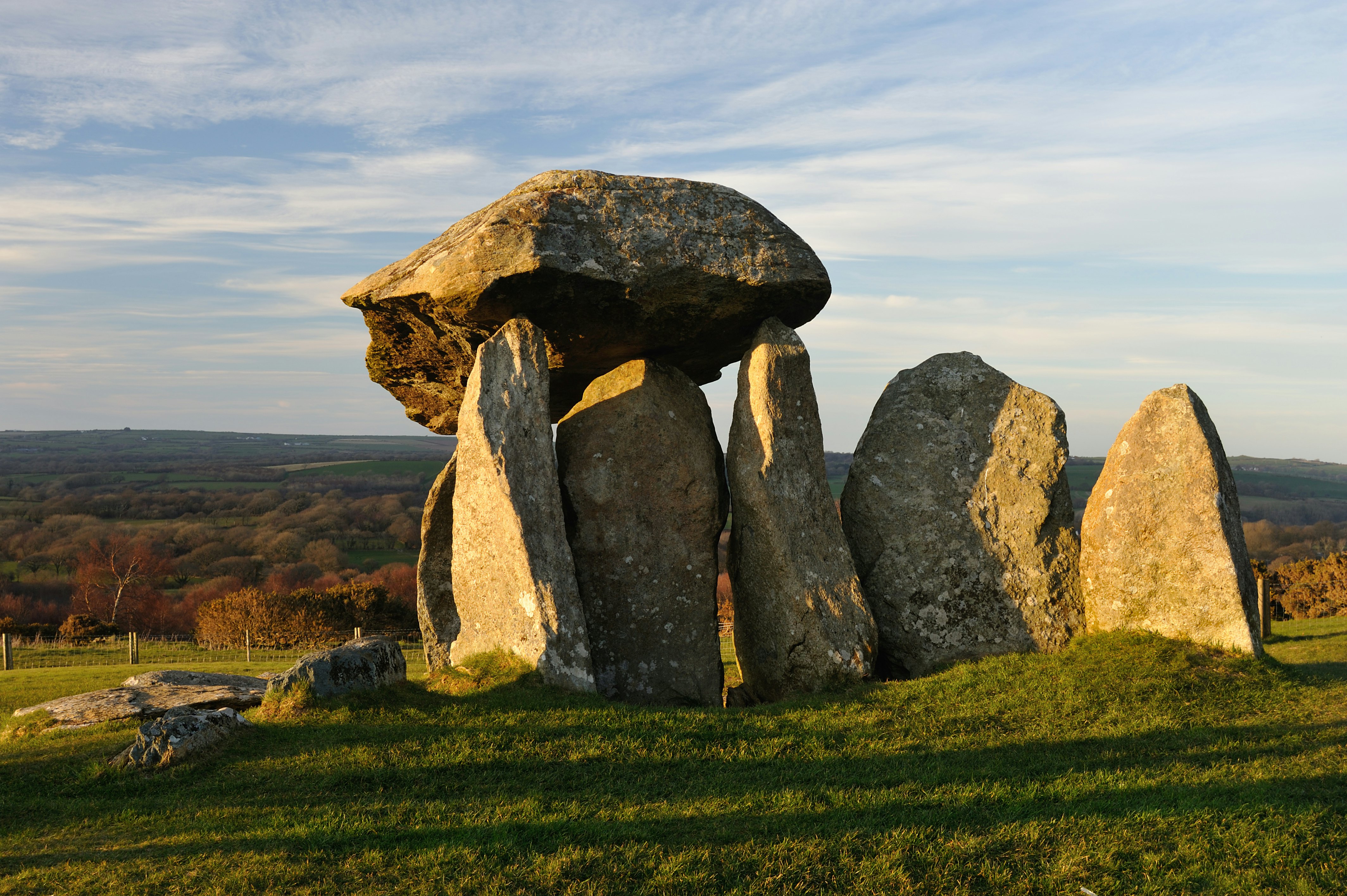
8. Contemplate the afterlife at Pentre Ifan
The largest ancient dolmen (tomb) in Wales, Pentre Ifan is a 5500-year-old Neolithic burial chamber set on a remote hillside with superb views across the Preseli Hills and out to sea. The huge, 5m-long (16ft) capstone, weighing more than 16 tonnes, is delicately poised on three tall, pointed upright stones, made of the same bluestone that was used for the menhirs at Stonehenge.
Planning tip: Free to enter, the site is about 3 miles (4.8km) southeast of Newport and is open from 10am until 4pm.
9. Rewind to the Iron Age at Castell Henllys
This authentically reconstructed settlement, with thatched roundhouses, animal pens, a smithy and a grain store, will transport you back to what an Iron Age Celtic village looked, felt and smelled like. From about 600 BC and right through the Roman occupation, there was a thriving Celtic settlement here, and it's been reconstructed on its original foundations.
The name Castell Henllys means Castle of the Prince's Court. For 27 years, students from around the world, supervised by the University of York archaeology department, have spent their summers digging and sifting at the site. In the process, they learned enough to build this remarkable recreation of the settlement, taking educated guesses about the clothing, tools, ceremonies and agricultural life of that time.
Costumed staff bring the site to life, stoking the fires and demonstrating traditional crafts, and wildlife such as bats and otters often put in an appearance. The idea is that you linger, experience and interact, not cruise through passively as in a traditional museum.
Planning tip: There's a cafe and a gift shop here (with occasional internet connectivity issues so bring cash if you want to make any purchases).
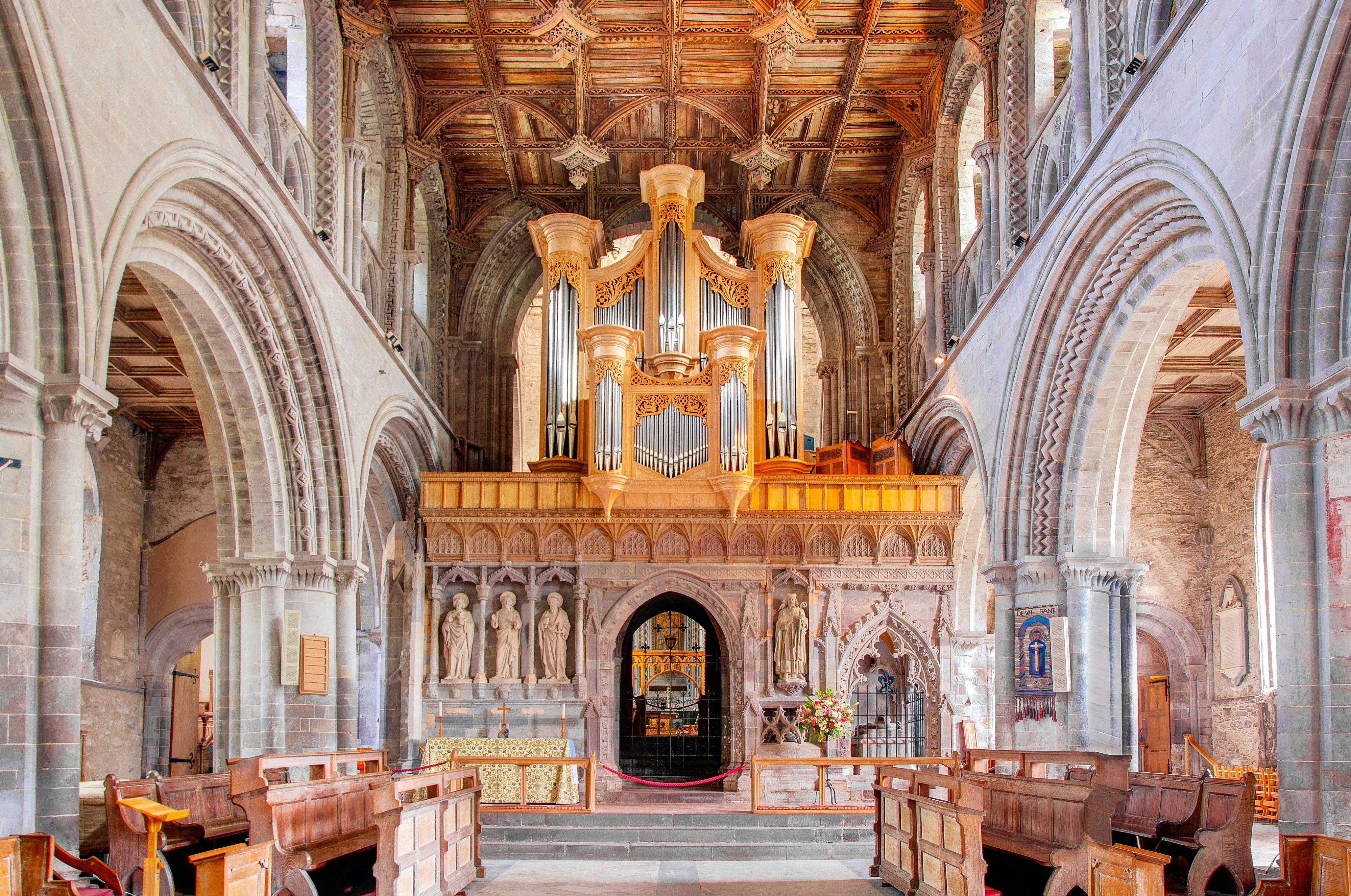
10. Admire the Norman cathedral at St David's
St David's Cathedral was built in a valley in the vain hope that the cathedral would be overlooked by Saxon raiders, but it was ransacked at least seven times. When you pass through the gatehouse and its stone walls come into view, the 12th-century Norman cathedral is astonishingly impressive, its distinctive west front embellished with four pointed towers of purple stone.
The nave is the oldest surviving part of the cathedral, with massive, purplish-grey pillars linked by semicircular Norman Romanesque arches. Check out the mischievous carved figures on the 16th-century misericords (under the choir seats), one of which depicts pilgrims being seasick over the side of a boat.
Between the choir and the high altar is the object of all those pilgrimages – a shrine containing the bones of St David and St Justinian. Destroyed during the Reformation, it was restored and rededicated in 2012, and adorned with five new Byzantine-style icons by artist Sara Crisp. Lord Rhys ap Gruffydd, the greatest of the princes of South Wales, and his son Rhys Gryg are buried in the cathedral, although their effigies in the south choir aisle date only from the 14th century.
11. Spend a day at the beach at Barafundle Bay and Stackpole Quay
Regularly topping polls as one of Britain's most sublime beaches, pinch-yourself-pretty Barafundle Bay is a highly scenic 10-minute walk south along the coast path from Stackpole Quay, or half an hour from the Stackpole Estate car park.
Enveloped by dramatic, ragged cliffs and flanked by dunes, the beach is a perfect arc of golden sand sliding into a clear turquoise sea. If you're up for more walking, follow the coast path south of the beach out onto Stackpole Head with its impressive sea cliffs and rock arches; it's a 1.6-mile (3km) return hike to the beach.
If you’re visiting with little ones, spending more time at Stackpole Quay may be more appealing than lugging children, food and beach paraphernalia over to Barafundle. You’ll find a sheltered stone quay where younger kids can paddle about when the tide is in, and kayakers and stand-up paddleboarders take off from here to explore the coastline nearby. There’s also more shade and a characterful tea room for afternoon ice creams.
Planning tip: Ideally, avoid summer weekends when the crowds descend, though there’s usually plenty of beach for everyone!
12. Walk the prehistoric Golden Road
Wending its way through the wild open moors of the Preseli Hills, the 7-mile (11km) Golden Road is a fascinating ramble through prehistory. Once part of a 5000-year-old trade route between Wessex and Ireland, it runs along the crest of this range of hills, beginning at Bwlch Gwynt near the summit of Foel Eryr.
The route passes stone cairns date from the Bronze Age, the Bedd Arthur standing stones on Carn Bica (supposed the resting place of King Arthur), the tors of Carn Menyn (believed to be the source of the bluestone for Stonehenge) and an Iron Age hill fort at Foel Drygarn, which also delivers outstanding views of the countryside you’ve just traipsed through.
Planning tip: Take a map as the path isn’t fully waymarked; the Pembrokeshire Coast website has a downloadable walking map.

13. Book a boat tour to Caldey Island
When Tenby swims with summer crowds, jump on the boat to Caldey Island, an offshore isle that has been inhabited by monks since the 6th century. Today, the island is home to around a dozen Cistercian monks who pray and – surprisingly – make chocolate.
The white-fronted, red-turreted abbey is off limits to visitors, but you can peek inside by attending services at 12:15pm and 2:20pm. Just south is St Illtyd's Church, with its oddly shaped steeple and a stone with inscriptions in Ogham (the language of early Celtic saints).
Beyond the abbey, the tug of the coast is strong. Walk to dune-fringed, powder-soft Priory Bay, or feel the beat of the sea while hiking the 2-mile (3.5km) West Cliffs circular walk. St Margaret's Island at Caldey’s western tip is a nature reserve, home to grey seals and Wales' biggest cormorant colony.
Planning tip: Tenby Boat Trips runs wildlife-spotting trips around the island’s Atlantic side. Go in autumn (September to November) to see seal pups.
14. See Church Doors carved by nature by Skrinkle Haven beach
Midway between Manorbier and Lydstep, on a wildly beautiful section of the Pembrokeshire Coast Path, you'll find two remarkable gold-sand-and-shingle coves – Church Doors and Skrinkle Haven – almost side by side. Skrinkle Haven is off limits at high tide, but at low tide, you can access its golden sands through a gap in the rocks. Just east, reached via a long flight of stairs, Church Doors is a geological marvel with stratified limestone and sandstone cliffs that have created a towering natural rock arch.

15. Kayak, stand-up paddleboard or try coasteering in the great outdoors
There are plenty of places to get out on the water around the coast of Pembrokeshire – all across the region. Join a kayak tour from Tenby North Beach or Saundersfoot Harbour; both give you the chance to spot wildlife in the sheltered waters of Carmarthen Bay.
If you haven’t heard of it before, consider booking a “coasteering” tour. Coasteering is a high-energy romp that was first invented on Pembrokeshire’s rugged coastline. It combines low-level rock traversing, exploring, sea swimming and leaping into the sea from different heights.
Planning tip: For something less adrenaline-fuelled, consider an afternoon serenely paddleboarding on the sandy bays and sheltered coves dotted along the South Pembrokeshire coast.
16. Cycle the Gwaun Valley Trail
Cwm Gwaun is quiet and uncrowded, oblivious to time and trends. Cutting a secretive path along narrow country lanes from Fishguard to the prehistoric standing stones of the Preseli Hills, this glacier-carved, thickly wooded valley moves to its own timeless beat.
Best explored by bike (or on foot), Cwm Gwaun offers up peaceful seclusion and a rich sense of mystery. Striking out on the 6-mile (10km) Gwaun Valley Trail will give you a fascinating overview, taking in historic marvels like the five cross-marked pillar stones in Llanychllwydog and St Brynach’s Church in Pontfaen, founded by the eponymous saint in 540 CE.
Beyond lies idyllic Sychpant Woods and Picnic Area, a Site of Special Scientific Interest that is home to rare lichens, butterflies, red kites, buzzards and kestrels. A path leads from here to a viewpoint gazing dreamily out across the valley to the Preseli Hills. Also be sure to check out the fabulously old-school Dyffryn Arms at Pontfaen.

17. Explore rock pools or go surfing on the Angle Peninsula
Out on its lonesome and all the more enticing for it, the village of Angle overlooks Wales' largest estuary and one of the world's deepest natural harbors. The surrounding Angle Peninsula offers terrific coastal walks with lots of rock pools to explore – it's a particularly lovely part of the Pembrokeshire Coast Path.
The big draw for beachgoers and surfers is wave-pummelled Freshwater West beach. Wild and windblown, this two-mile strand of golden sand and silver shingle backed by acres of dunes is one of Wales' finest surf beaches, sitting wide open to the Atlantic rollers. But beware – big waves, powerful rips and quicksand make it unsuitable for swimming.
Edging north brings you to the pretty horseshoe-shaped cove of West Angle Bay, peering across the mouth of Milford Haven to St Anne's Head. Pop into the nearby Old Point House for seaweed-inspired food at Cafe Môr, the world's first solar-powered seaweed kitchen, run by passionate forager Jonathan Williams and set in a converted fishing boat. Try the lobster rolls with Welsh Sea black butter, and fish butties with homemade pickles and seaweed-chilli sauce.
18. Hide out in St Govan's Chapel
One of the most dramatic sights on this extraordinary stretch of coast is this 13th-century hermit's chapel, wedged into a slot in the cliffs, just out of reach of the sea. Steps hacked into the rock lead down through the empty shell of the structure and on to the rocks below, where there's a particularly picturesque rock arch, perpetually pounded by the waves.
The chapel is named for a 6th-century Irish preacher who, according to legend, was being pursued by pirates when the cliff conveniently opened and enfolded him, protecting him from his attackers. In gratitude, he built the original chapel and lived here until his death in 586 CE.
Planning tip: The road to St Govan's passes through Ministry of Defence land, and is sometimes closed because of activity on the Castlemartin firing range; check the schedule before you head out.
19. Catch a music festival in Fishguard
Perched on a headland between its ferry port and fishing harbour, Fishguard is often given the short shrift by travellers on the mad dash to and from Ireland. But this appealing town is one of Pembrokeshire's most culturally vibrant.
Making the Celtic connection with Ireland just across the water, the town reverberates with music in summer. Time your visit to catch May's Folk Festival, July's International Music Festival or August's Aberjazz festival to see Fishguard at its lively, toe-tapping best.
Detour: Link up to the Pembrokeshire Coast Path and walk north along the craggy coastline to reach Carreg Wastad Point, the site of the last invasion of Britain in 1797. An intricate tapestry on permanent display in the town hall gallery recounts the moment when French forces stormed the shores.
20. Sleep in a proper castle
It's not every night you get to stay in a 12th-century Norman castle, but you can do just that at the luxe Roch Castle outside St Davids. Perched on a crag offering far-reaching views across farmland and out to sea, this luxurious bolthole bears the slickly minimalist hallmark of Welsh-born architect Keith Griffiths.
A spiral staircase twists up from the lobby to zen-like rooms decorated in whites, dove greys and charcoals, with bespoke ceramics and rich fabrics. All the rooms have been designed with a razor-sharp eye for detail, with espresso makers, bathrobes and aromatherapy-infused toiletries.
There are nods to the castle's history in the original details and design, from the arch stone windows in the guest lounge to the specially commissioned tapestries and visible sections of the castle's foundations in the lobby.
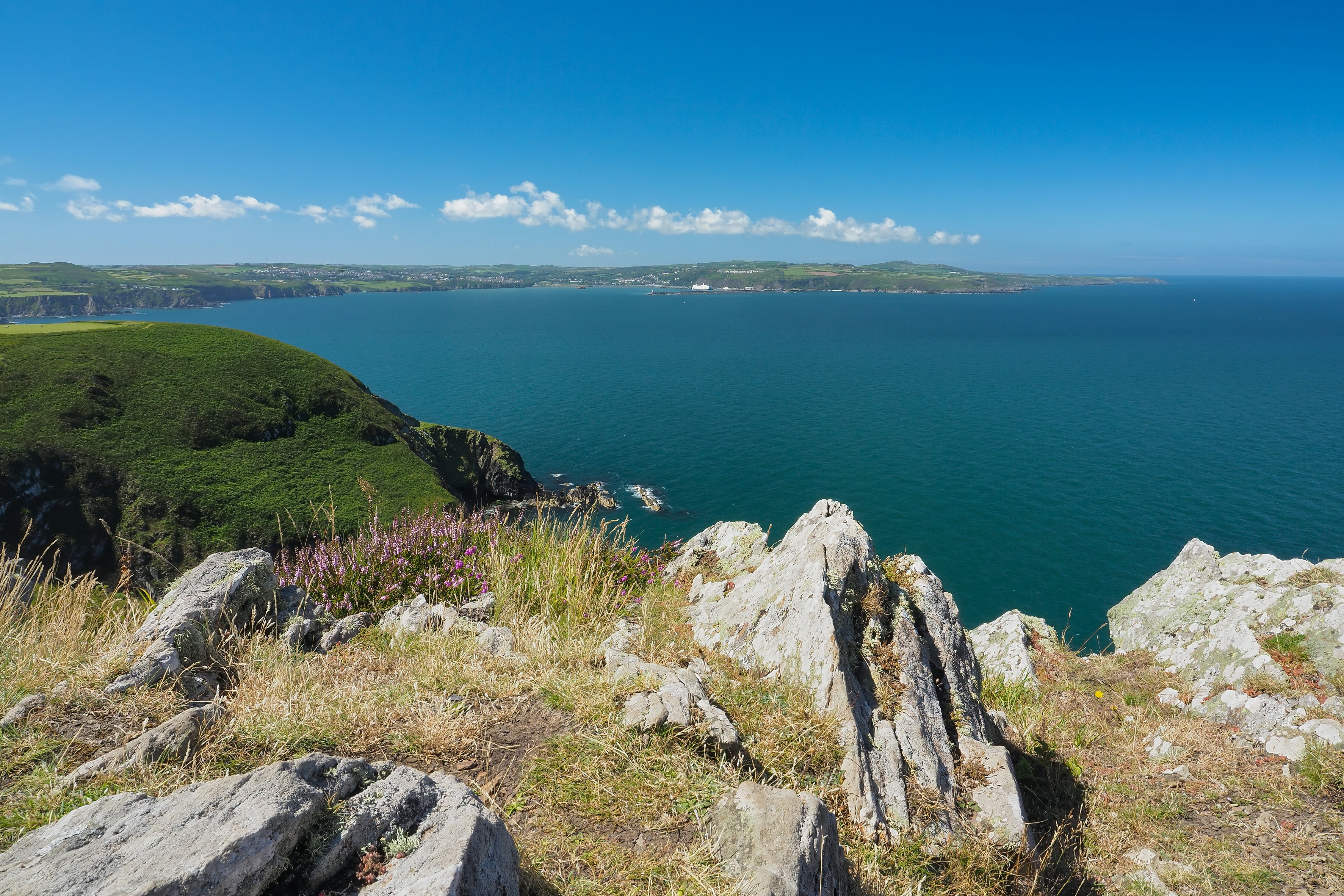
21. Walk the Dinas Head circuit on Dinas Island
Take a walk around one of the most ravishing coast-scapes in Pembrokeshire – the rugged headland of Dinas Island between Fishguard and Newport. It's not really an island as it's anchored to the mainland by a narrow neck of land, framed on either side by pretty coves – the sandy strand of Pwllgwaelod to the west, and the rocky inlet of Cwm-yr-Eglwys to the east, where you can see the ruins of the 12th-century St Brynach's Church, destroyed by the great storm of 1859.
A rewarding circuit walk around the headland (3 miles/4.8km) heads up and over cliffs cloaked in gorse, blackthorn and bramble, passing precipitous, deeply grooved, largely inaccessible coves. The rumble of the sea is the backbeat on the trail, and there's a chance of spotting seals and dolphins from the cliffs at Dinas Head, the northernmost point. In late spring and summer, look for puffins at Needle Rock. A path across the neck between Pwllgwaelod and Cwm-yr-Eglwys allows you to return to your starting point.
This article was adapted from Lonely Planet’s Wales guidebook, published in June 2025.













